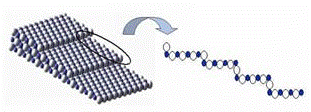Chemistry, Department of: Faculty Series

Marjorie A. Langell Publications
Document Type
Article
Date of this Version
December 2005
Abstract
The surface crystal structure of the Co3O4(1 1 0) spinel was characterized by low energy electron diffraction (LEED), X-ray photoelectron spectroscopy (XPS), and Auger electron spectroscopy (AES). Well-defined LEED diffraction patterns showed an unreconstructed Co3O4(1 1 0) surface in Type A termination, and XPS and Auger indicated the surface to be stoichiometric with octahedral and tetrahedral cation sites occupied by 3+ and 2+ cations, respectively. The experimental lattice parameters of 8.22 Å ± 0.2 Å and 5.50 Å ± 0.2 Å in the (0 0 1) and (1¯ 1 0) directions, respectively, are in agreement with a bulk-terminated unit cell.
The impurities: K, Ca, Na, and Cu segregated to the surface after prolonged heating to 630 K. K, Ca and Na could easily be removed by routine cleaning procedures and did not affect the Co3O4(1 1 0) structure or stoichiometry detectably in the submonolayer levels at which they were observed. However, the copper impurity resulted in the formation of a Cu2O(1 1 0) overlayer, with the accompanying reduction of the spinel surface to a rocksalt metal monoxide-like surface. The copper oxide formed a distorted hexagonal overlayer incommensurate with that of the Co3O4(1 1 0) stoichiometric surface and with periodic spacings of 3.86 Å ± 0.2 Å in the (0 0 1) and 4.10 Å ± 0.2 Å in the (1¯ 1 0)directions in agreement with Cu2O(1 1 0) bulk termination. The Co3O4(1 1 0) substrate could not be fully re-oxidized until all detectable copper had been removed from the surface.


Comments
Published in Surface Science 599:1-3 (December 30, 2005), pp. 27–40. doi:10.1016/j.susc.2005.09.034 Copyright © 2005 Elsevier B.V. Used by permission. http://www.sciencedirect.com/science/journal/00396028